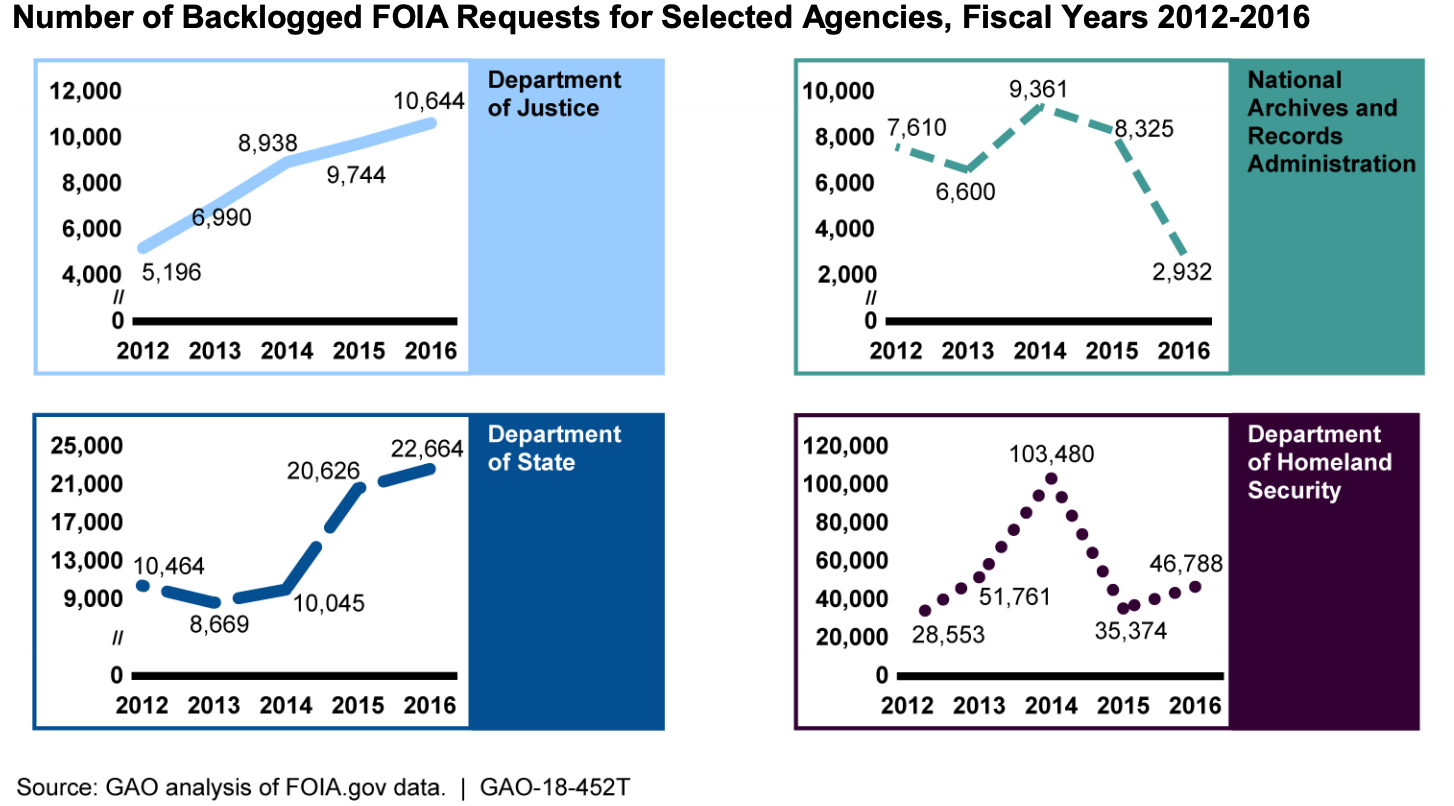How RPA is Accelerating Freedom of Information Act Response Times

In the United States (U.S.), there are some 18,000 cities, 3,100 counties, 50 states, and 400 federal organizations and they all have a growing challenge. While open, transparent, and citizen-driven government really only started in 1967 today we have come to expect it.
In 1967, the U.S. Congress enacted the Freedom of Information Act (FOIA). Its intent is to ensure citizens know how their government governs. Federal agencies must disclose any information requested under the FOIA. Exceptions apply only when the information falls under one of nine exemptions. These exemptions protect interests such as personal privacy, national security, and law enforcement. Few would argue this is not a positive law that informs us all. To provide this openness the federal government spends $550 million asking nearly 5,000 full-time employees to full fill FOIA requests. Yet the backlog of FOIA requests continues to increase by 30%.
While cities, counties, and state governments (SLG) are not covered under FOIA, all have similar openness policies (sunshine laws, open records laws, etc.). In this digital age, citizens expect prompt responses to their requests. There has been a steady increase of request backlogs in the last few years. As a result, agencies must hire more staff, or the response time slows down. Additionally, policy mandates have driven up operational costs. The bad press from the backlog also weighs on the psyche of an agency.
Yet, the reality is that many, if not most, federal agencies are not able to meet the service level agreement (SLA) set forth by Congress. According to Congress, federal agencies must respond to a FOIA request within 20 days of receiving the request. States vary in their SLAs but generally, states respond to requests for information within four to eight business days. Agencies are reporting the increase backlog (year over year) via their “FOIA Backlog Management Plans” (see below).

Earlier, we said that open government is good governance. Responding to FOIA type requests takes either dedicated staff or part-time staff. When part-time staff takes on FOIA fulfillment it takes them away from their primary mission. Copying and packaging costs must also be considered. Those are costs paid with U.S. citizens’ tax dollars (although some agencies are attempting to adopt a fee-for-service model). Consider the following examples of the scope of this work:
Health and Human Services (HHS) is a top-five agency for receiving and processing FOIA requests. During Fiscal Year (FY) 2019, HHS received a total of 35,358 FOIA requests. The number of FOIA requests submitted to each HHS department varies, ranging from a low of 162 requests by Indian Health Services to a high of 16,694 FOIA requests by the Center for Medicare and Medicaid Services.
HHS closed 33,817 FOIA requests in FY 2019. Currently, 244 HHS employees work full time on FOIA issues. (NOTE: In other words, $14,640,000 was spent for 244 employees with fully burdened salaries of $60,000).
What if HHS could redeploy half of these employees on more critical mission needs?
Susan Gray Eakin, a digital archives coordinator, led the project to post and make records searchable at the Library of Virginia. To archive former Virginia Governor Tim Kaine’s records she needed to digitize 900 boxes of paper records and almost two million electronic records.
The library’s meager budget and an eight-year period of staff reductions meant only four part-time and one full-time archivists could work on the project. Her staff is manually:
Reviewing records for anything that should be redacted (I’ll explain more on redaction shortly)
Scanning the documents to PDF formats
Loading the PDFs to storage
Shipping the PDFs, at two cents per page, to Waterloo University in Canada for artificial intelligence (AI) support
The library estimates needing a $410,000 annual budget for this project and a one-time $642,000 to do this work. In all, the library estimates it would need four new permanent archivists at a cost of $410,000 annually and $642,000 for a one-time contractual service to complete the work. They need more funds if the project needs to be expedited.
Why the backlog?
Responding to FOIA requests require staff and comes at a cost. Some agencies have full-time staff and others part-time to no staff. The cost to copy, process, and report costs each agency resources (i.e. taxpayer dollars or fee for service).
Cynics may say government employees don’t want to provide the information. The high percentage of FOIA requests fulfilled suggest this is not the case.
Then why, if federal agencies all have backlog reduction plans, is the backlog continuing to grow?
The federal SLA does not begin until the proper agency or office receives the request, so this contributes a little to the backlog. Ok, bureaucracy adds a little to the backlog.
Agencies may exceed the 20-days SLA if they need to request more information from the submitter (though, admittedly if an agency reaches out on day 19 for more information that could be a small contributor to the backlog).
U.S. states, under much tighter budget constraints than the federal government, are attempting to comply with the important need to provide information by creating a fee for the service and this is not sitting well with some. Again, a small bureaucratic contribute to the backlog.
Staffing is an issue. While the top five agencies (outlined in the next point) may have a couple hundred people working on FOIA requests, that is atypical. Most agencies create teams based on the scope of work and states like Virginia (see my example above) are understaffed. Connecticut is in a battle around FOIA requests as they have one FOIA-related staff member and the state routinely has FOIA backlogs of two years. Staffing certainly contributes but how many people do we want on staff and at what cost?
In 1967, it was reasonable to assume that new media would be asking for and reporting this information. Fast forward 50 years and in FY 2018 U.S. federal agencies received 45,458 FOIA requests (more than the 863,729 requests in FY 2017). The Department of Homeland Security (DHS), Department of Justice (DOJ), United Stated Department of Agriculture (USDA), and the National Records and Archives Administration (NARA) make up 70% of the FOIA workload. The volume of incoming FOIA requests vastly outpaces the 5,000 people across the country who are paid to respond to the requests.
Now, I have to say that in my thirty-two years of working in the U.S. government, I didn’t run across anyone who disliked doing FOIA work because they wanted to withhold information. Instead, I saw government employees disliking FOIA-related work because it was a pain to do the work and the often had to work overtime.
Why does the work turn into overtime? Let's dive a bit more into redaction (and what that work entails).
Redacting means to hide or remove (confidential parts of a text) before publication or distribution, or to examine (a text) for this purpose. Redacting is the major activity associated with most information releases. It's critical to determine if the document contains information that is exempt from FOIA.
As you read in the Library of Virginia example, people have to read every document, highlight confidential information on the document, have it reviewed, and then cover the confidential information.
Until now.
A possible end to the FOIA backlog mountain
Let's look at a solution available today. It’s a solution that allows agencies to stop hiring thousands of people to perform boring, tedious, and error-prone work. Let's allow agencies to reboot the way they work and end unnecessary FOIA backlogs.
In the past, FOIA requests were almost exclusively from media outlets (television and newspapers). Today, the general public can submit a FOIA request in person, via mail, or by filling out an online form. Being able to submit the requests online has helped spur increases in FOIA requests. As a result, U.S. government agencies (at all levels) need to respond at the speed of digital to prevent additional backlog.

The software robot in the video, built by UiPath employee Bernard Lawes, is poised to make FOIA backlogs a thing of the past.
Imagine heading out the door on Friday and telling your digital reviewer to redact 100,000 emails for Monday morning. Your UiPath Orchestrator realizes it cannot complete the task by Monday morning and dynamically assigns idle robots the task to ensure it meets the Monday morning deadline. Your robot is part of the UiPath Platform (built for hyperautomation) and thus tied to a machine learning model using UiPath AI Fabric.
Monday morning, you come in to find that it completed 98,325 emails but the confidence level you set forced it to ask you to adjudicate the remaining 1,675 emails. You don’t have to guess as it shows you exactly where it is confused and when you tell it the correct answer, it updates the model to be better next time. From Friday to Wednesday, the work of redacting 100,000 emails is completed: 100% done with 100% accuracy.
PDF Redactor Robot can run as an attended or unattended robot. Watch the video (above) and think about the last time your office asked 10 or 20 employees to do redaction work over a period of weeks. It only takes a minute to appreciate the tremendous opportunity presented by this robot.
With this version of the PDF Redactor Robot, you can let the robot highlight everything to redact. Then, until you fully trust your digital assistant, have a human in the loop to verify the work.
In our democracy, we have legislated and passed local policies to provide as much transparency as practical (not as possible). This naturally comes at a cost (people and dollars). There is a tipping point where we cannot afford to provide it fast, but we can eventually provide it.
Well, we can’t provide transparency quickly and accurately when you are dealing with personally identifiable information (PII) or national security secrets. In those instances, fast and inaccurate costs more than we can afford. However, we have to assume FOIA requests are going to come faster and for more information as digital becomes more and more prevalent.
It is time to automate
When the USDA was asked if the agency is “leveraging technology to facilitate efficiency in conducting searches, including searches for emails,” the response was positive. Yet, while the Office of the Chief Information Officer (OCIO)’s Client Experience Center (CEC) was able to purchase an add-on tool to the department’s enterprise-wide tracking system that enables FOIA components due to budget constraints, only a few licenses were purchased.
Given the value proposition to reallocate people off of mundane, tedious, and boring work, to save millions of dollars, and avoid costly legal battles, the PDF Redactor Robot is a must-have tool.
I could not agree more with the HHS plan for reducing their FOIA backlog:
"As the average age of federal workers rises and increasingly larger numbers of federal employees are eligible for retirement, the Department is preparing for the impact of this demographic trend on the HHS FOIA community by implementing succession planning to maintain the necessary alignment of critical skills in the agency workforce, so that we may continue to serve the requester community in the best manner possible."
If you're ready to decrease the FOIA requests backlog in your agency, contact us today. Let Bernard show you the PDF Redactor Robot live. Challenge it. If your agency is already using UiPath, consider downloading the robot from our Marketplace (it's free!) and trying it out.
'Look under the hood' of the PDF Redactor Robot to see how your agency can save millions, be more accurate, and increase compliance with federal policy. We cannot wait to show it to you.
The PDF Redaction Robot will also be featured on our upcoming 'a robot for every person' webinar. Join us for the webinar!

Senior Vice President, Public Sector, USA, Roboyo
Get articles from automation experts in your inbox
SubscribeGet articles from automation experts in your inbox
Sign up today and we'll email you the newest articles every week.
Thank you for subscribing!
Thank you for subscribing! Each week, we'll send the best automation blog posts straight to your inbox.


